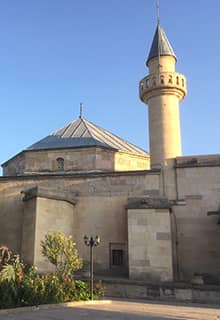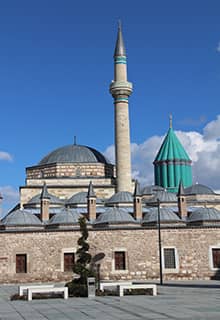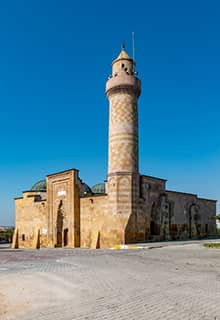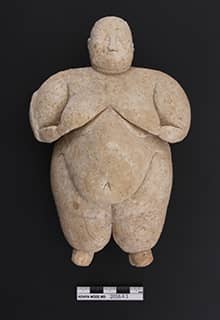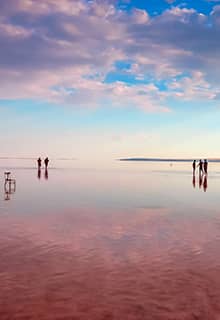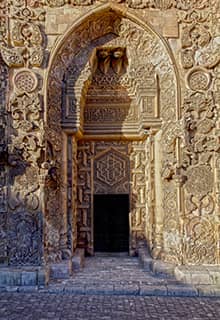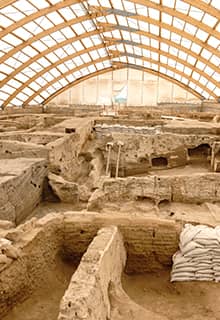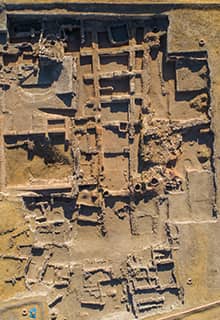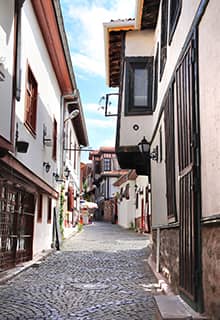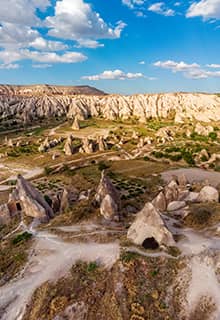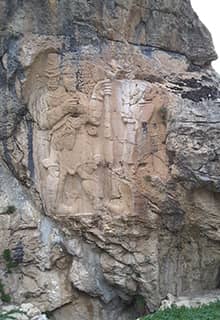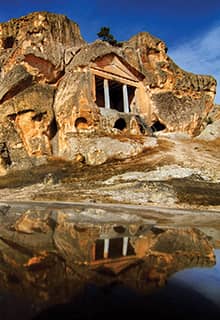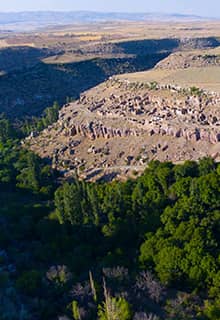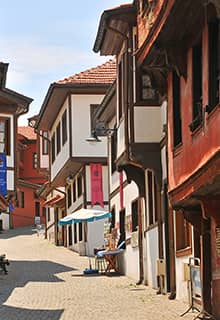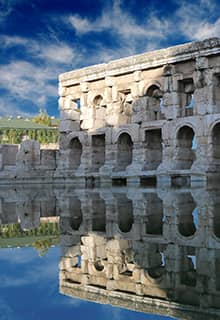

Central Türkiye
UNESCO Heritage Sites and Routes
Great Mosque and Hospital of Divriği, Sivas
UNESCO World Heritage Site 1985
Sivas is the principal city of Central Türkiye and has always been a gateway from the east to Central Anatolia. Divriği, 150 km east of Sivas, is famous for its Ulu Mosque (Great Mosque) Complex. The complex consists of a mosque and a hospital that is attached to it. An important detail is the use of shadows in the three-dimensional ornamentation of the two entrances of the mosque, which cast a giant shadow of a praying man that changes his pose as the sun moves. The interior of the mosque consists of stone piers which support the stone vaults. The hospital is entered through a portal located on the western façade. The interior of the hospital features rooms placed around a roofed courtyard with a small pool in the center. The whole complex was built in the 13th century, during the Seljuk period. The exquisite carvings and architecture of both buildings place them among the most important works of architecture in Anatolia.
Neolithic Site of Çatalhöyük, Konya
UNESCO World Heritage Site 2012
Çatalhöyük is 40 km east of Konya, close to the modern town of Çumra. When it was first excavated in 1960, Çatalhöyük was identified as the first urban city settlement in the world. The rooms that were discovered at Çatalhöyük were believed to be temples and the complicated social organization of Çatalhöyük distinguished it from other Neolithic settlements. The elegantly decorated houses and the elaborate artifacts that were found here indicate a sophisticated society that goes beyond what could be associated with a village. Hundreds of statues of the Anatolian Mother Goddess, wall paintings, and other artifacts unearthed at Çatalhöyük can be seen at the Museum of Anatolian Civilizations in Ankara. The excavations at Çatalhöyük revealed 18 layers of Neolithic settlements dating between 7400 and 6200 BC at the Eastern Mound. The houses here were made using sundried bricks. There were no streets and alleys between the houses, and entry to the houses was provided via the roofs. The excavations have shown that the people of Çatalhöyük were hunters and fisherman, that they domesticated wheat and barley, and brought obsidian from considerable distances.
Göreme National Park and the Rock Sites of Cappadocia, Nevşehir
UNESCO World Heritage Site 1985
Göreme is perhaps the most well-known town in the region of Cappadocia. In fact, Göreme is often used synonymously with Cappadocia. Göreme is located in the center of Cappadocia, some 12 km east of the provincial capital city of Nevsehir. The town of Göreme resembles a fairy tale with its rock dwellings, the beautiful traditional houses made of the local tufa limestone, and the wonderful cave hotels providing travelers unique accommodation. The town’s fame derives from the nearby Christian monasteries that date back to the 8th – 11th century which have been declared an open-air museum. The Göreme Open-Air Museum is located 4 km east of the town and can be easily reached. The site is a huge monastic complex composed of scores of refectory monasteries placed side-by-side, each with its own church. The rock-cut churches often feature beautiful frescoes. The Göreme Open-Air Museum was one of the first two UNESCO sites in Türkiye.
Konya, A Capital of Seljuk Civilization
UNESCO World Heritage Tentative List 2000
Konya, or ancient Iconium, is the principal city of Central Anatolia, situated next to the Lake Tuz, Türkiye’s second-largest lake and one of the world’s largest hypersaline lakes. Konya is on southwestern edge of the Central Anatolian Plateau, the country’s breadbasket. The city is a cradle of many civilizations and in the recent past rose to prominence by virtue of the important Neolithic settlement of Çatalhöyük. The city became a center of culture and politics in the Seljuk period, when it was chosen as the capital in the 12th century. Konya was also the home of the world-famous mystic and poet Mevlana, best known in the West as Rumi, who made the Mevlevi Order and the whirling dervishes known across the globe. In the 12th and 13th centuries, many public buildings, prime examples of Seljuk stonemasonry, were built here. The Seljuks created a unique artistic world with cultural links reaching out from the Anatolian heartland to Central Asia, the Middle East, and the shores of the Mediterranean. The outer fortress of Konya and the Alaaddin Mosque, the Sırçalı Medrese (madrassa), and many small mosques and tombs are examples of Konya’s Seljuk architectural elements.
Gordion, Ankara
UNESCO World Heritage 2023
Gordion is perhaps one of the most interesting ancient cities in Türkiye. It was the capital city of the Phrygians, a great culture and civilization of the 9th – 8th centuries BC. Gordion is located 70 km southwest of Ankara, in the district of Polatlı. Perhaps the name “Phrygia” is not known by many, but the Phrygians’ most famous king, King Midas, is known the world over. King Midas, according to Greek mythology, had the “golden touch”: everything he touched turned to gold. Midas’s father, Gordios, the founder of Gordion, is equally famous: he was the maker of the Gordion Knot. The knot could only be loosened by Alexander the Great and according to a local prophesy the person who succeeded in doing so was destined to be the ruler of entire Asia. Recent research in Gordion has revealed that the Phrygian language appears at least 50 years before Greek. The main settlement mound lies on the Sakarya River in the village territory of Yassıhöyük. It consists of multiple layers of archaeology and many of the findings from the excavation can be seen at the museum at the site. In the vicinity of Gordion there are approximately 150 earthen burial mounds or tumuli; the highest one is the so-called Midas Tumulus which is a masterpiece of this period of history.
Sivrihisar Great Mosque, Eskişehir
UNESCO World Heritage Tentative List 2016
Sivrihisar is located 70 km east of Ankara in Sivrihisar, a town in Eskişehir Province. Sivrihisar hosts one of the few wooden mosques that have survived from the Seljuk period. The Sivrihisar Great Mosque, or Sivrihisar Ulu Mosque (Sivrihisar Ulu Cami), was built in the early 13th century. The roof of the mosque is held by 67 wooden columns, which were made from juniper and yellow pine, while ancient capitals are used as column bases. The delicate woodwork of the pulpit, made of walnut wood, is a masterpiece of Seljuk art. On the gate wing of the pulpit, the craftsman “Hasan bin Mehmed” carved his name.
Haci Bektaş Veli Complex, Nevşehir
UNESCO World Heritage Tentative List 2012
The Haci Bektaş Veli Complex is located in Hacibektaş, 45 km from Nevşehir, the principal town in Cappadocia. Haci Bektaş Veli was a great Turkish mystic and philosopher of the 13th century and the founder of Bektashism, a religious order of Alevism. The base of Haci Bektaş Veli’s philosophy lies on humanity, human rights, and social equality for men and women. He counsels human to be modest, to purify his soul, to mature, to abstain from showing off, and to be full of love for God. His principles led to cultural harmony and enlightening in Anatolia. The belief system of Bektashism, based on the “Love of Universe-God-Man,” spread rapidly throughout Anatolia after his death. Bektashi dervishes also spread to different parts of the world in order to disseminate the Bektashi humanity in the world. Today, Bektashism lives on not only in Hacibektaş, but in many countries and particularly in the Balkans and the Middle East.
The complex was founded in the 14th century and follows the pattern of Turkish palaces with courtyards, around which the units were organized according to their functions. The complex consists of buildings around three courtyards. It was built by simple stonemasonry and decorated with ornaments particular to Bektashism. It has witnessed many additions and comprehensive restoration over time. Its current form dates back mainly to the 16th century.
Lake Tuz Special Environmental Protection Area, Ankara
UNESCO World Heritage Tentative List 2013
Lake Tuz (lit. Lake Salt) is one of the most important natural environments in the world with its distinguished flora and fauna. It is the second-largest lake in Türkiye after Lake Van. The lake is located within the boundaries of three cities: Aksaray, Konya, and Ankara. Lake Tuz is situated in a closed basin and has a geologically tectonic origin. The lake and the surrounding areas were declared an area of natural importance in 1992 and were consequently designated as a “Special Environmental Protection Area (SEPA).” Lake Tuz is Türkiye’s most important natural salt source, and an important bird habitat.
Anatolian Seljuks Madrasahs, Konya, Erzurum, Sivas, Kayseri & Kirsehir
UNESCO World Heritage Tentative List 2014
The Seljuk period is a turning point in the history of Anatolia. Anatolia became extremely wealthy and prosperous during the Classical, Hellenistic, and Roman periods; however, it fell into a deep silence during the Byzantine period. The arrival of the Seljuks in the 11th century and the establishment of a new empire suddenly changed this scene. The Seljuks created great art and architecture that heavily influenced the Ottoman art and architecture that followed. The madrassa, which was an educational institution, was one of the keys to the success of the Seljuks. Among numerous madrassas in Türkiye from this period, the ones in Konya, Erzurum, Sivas, Kayseri, and Kırşehir are especially worth seeing.
Archaeological Site of Kültepe-Kanesh, Kayseri
UNESCO World Heritage Tentative List 2014
Kanesh was called “Neşa” by the Hittites and was perhaps their first capital city before they moved to Hattusa. The site of Kültepe, which was the capital of the ancient Kingdom of Kanesh and a center of Assyrian trade colonies in the 2nd millennium BC, is located some 20 km northeast of Kayseri. The topographical position allowed Kültepe to be a center of ancient politics and trade, and Kültepe became a key center of culture and commerce between Anatolia, Syria, and Mesopotamia by the end of the 3rd millennium BC. The first writing arrived at Anatolia through Assyrian merchants and hundreds of clay tablets were unearthed in Kültepe. The site consists of two parts: the upper mound called “Kanesh” and the lower called “Karum.” A visit to Kültepe is ideally complemented with a visit to the Museum of Anatolian Civilizations in Ankara.
Eflatun Pinar: The Hittite Spring Sanctuary, Konya
UNESCO World Heritage Tentative List 2014
Eflatun Pinar (Eflatunpınar in Turkish) is located 25 km north of Beyşehir, which is named after Lake Beyşehir, the third-largest lake of Türkiye. It is a remarkably well-preserved Hittite water monument, dating from the 13th century BC. Hittites ruled almost all of Anatolia and influenced the Assyrian and Egyptian areas in the 2nd millennium. Beyşehir was on the main road to the Taurus Mountains, where perhaps a summer residence for Hittite kings once existed. The Eflatun Pinar water monument is related to this lake and was constructed as a tribute to the water gods. The monument is a rectangular pond fed by the waters from a spring on the spot. The most prominent part of the monument is a relief-covered wall of huge boulders on the north edge of the pond. At the center, a divine couple is represented: the Hittite storm god and the sun goddess. Around them are ten spirits or hybrid creatures supporting the two-winged sun disks above the gods and an enormous, winged sun disk at the top. The base has five mountain gods that are partially visible.
Tomb of Ahi Evran, Kırşehir
UNESCO World Heritage Tentative List 2014
Ahi Evren (Ahi Evren) is one of the most important figures of the 13th century. He was a Turkish philosopher and the founder of the “Ahi Order,” an organization that established a system for craftsmen and guilds so that they could work together under a rule where their rights and benefits were guaranteed. The Ahi Order is closely related to “brotherhood” (“Ahi” means “brother” in Arabic) and brought together the notions of “artisanship, trade and profession” with “maturity, morality and truth.” This system is still in place today despite the decline in craftsmanship labor in recent times. Ahi Evren’s symbolic tomb is composed of a diwan and two chambers. The tomb is in the north chamber; the south chamber has been recently restored and is designed as a showroom.
Mountainous Phrygia, Eskisehir, Kütahya & Afyon
UNESCO World Heritage Tentative List 2015
The Phrygian Valley is a huge triangle between Afyon, Kütahya, and Eskişehir that is full of unique and wonderful monuments from the Phrygian period (9th-8th centuries BC). In recent years, a walking trail (Phrygian Way) has been established in this area; it takes a minimum of a week to walk this beautiful landscape. Along the region’s deep valleys, castles, mounds, tumuli, necropolises, rock-cut places of worship, inscriptions and reliefs, altars, cisterns, and monumental rock-cut tombs stand as testimonies of the Phrygian culture of yesteryear. Special areas of interest include the Göynüş Valley, Ayazin, Döğer, and Lake Emre. The open-air sanctuary of Yazılıkaya (also called Midas City) contains some of the most remarkable rock monuments of the Hittite civilization.
Historical Monuments of Niğde, Niğde
UNESCO World Heritage Tentative List 2012
Niğde is a picturesque small town in Central Anatolia at the exit of the famous Cilician Gates. Lying on a plateau embellished by volcanic peaks, in the Hittite period, Niğde used to be called "Nahita." Since its foundation, it has been a commercial center, standing on the ancient trade route between Anatolia and the Mediterranean. When it was conquered by the Seljuks, they filled the city with structures that represented the exquisite Seljuk artistic and architectural styles. The historical core of the city is located in the district of Alaeddin, which is situated on the hill known today as the “Hill of Alaeddin.” The Alaeddin Mosque is one of the most important structures on the hill along with the citadel, the Sungur Bey Mosque and tomb, and the Hüdavend Hatun Mausoleum built in 1312. The 15th-century Ak Madrassa has been converted to an archaeological museum.
Haci Bayram Mosque and Its Surrounding Area, Ankara
UNESCO World Heritage Tentative List 2016
The Haci Bayram Mosque is in the district located at the edge of the Ankara Citadel, in Ulus. The area where the Haci Bayram Mosque and the Temple of Augustus are located has a traditional historical layout. It contains buildings from the Ottoman and Early Republican period, like the first parliament building of Türkiye dating back to 1923. The district is located on a hill which was a tumulus. The Haci Bayram area was once the acropolis of ,ancient Ankyra, starting in the 8th century BC, and throughout time it has been a sacred area where people of different faiths worshiped next to one another.
The Haci Bayram Mosque, which was founded in the 15th century, is one of the most important mosques of Ankara. It was renovated in the 18th century, taking on characteristics of that period. Its most significant feature is that it was built without a dome but with a wooden ceiling covering the main interior space. The mosque was built by architect Mehmet Bey.
Basilica Therma (Sarikaya Roman Bath), Yozgat
UNESCO World Heritage Tentative List 2018
The Roman spa town of Basilica Therma (Sarıkaya Roma Hamamı) in is Yozgat Province's Sarıkaya district. It is also known as "Kral Kızı Hamamı," the King's Daughter’s Bath. According to historians, the bath’s thermal waters were believed to have healed a terminally ill daughter of a Roman emperor, who once lived in the province Kayseri. The Roman bath built here is admired for its historical features, architecture, and healing waters, which have been flowing for over 2,000 years. The ruins were unearthed during excavations carried out by Sarıkaya Municipality and the Provincial Directorate of Culture and Tourism in 2014.
Early Period of Anatolian Turkish Heritage: Niksar, The Capital of Danishmend Dynasty
UNESCO World Heritage Tentative List 2018
Niksar, a town in the province of Tokat, has always been an important center in Anatolia by virtue of its strategic location, climate, and productive farmland. Niksar is located on the intersection point of roads coming from modern-day Iran, extending to Central Anatolia, the Aegean regions and İstanbul, as well as Anatolian routes from the south to the Black Sea. Throughout time, Niksar has been ruled by the Hittite, Persian, Greek, Pontic, Roman, Byzantine, Danishmend, Seljuk, and Ottoman Empires. In the Middle Ages, the Muslims and Christians disputed the possession of Neocaesarea (Niksar’s name in the Roman period), and in 1068, the Seljuk general Melik-Ghazi captured the city and pillaged it. Later, following Byzantine rule, Melik Gümüştekin Ahmet Gazi (known as Danishmend Gazi), founder of the Danishmend dynasty, conquered Niksar. He made it his capital city, and under the name “Niksar,” it became a center of science and culture. The mausoleum of Danishmend Gazi stands in a large cemetery just outside the town.
İvriz Cultural Landscape, Konya
UNESCO World Heritage Tentative List 2017
The İvriz Cultural Landscape site includes two large Neo-Hittite rock reliefs, a small Neo-Hittite altar, a Byzantine monastery, and several natural features. The İvriz rock relief is one of Türkiye’s most important Hittite monuments. The monument is located near the village of İvriz, 12 km from the modern city of Ereğli. It is carved on a rock near a large spring and depicts King Warpalawa(s), the 8th century BC local Hittite King of Tuwanuwa, worshipping the weather god Tarhunza who holds wheat bundles in one hand and bunches of grapes in the other. The hieroglyphics inscribed on stelae are in Luwian, an Indo-European language of the Anatolian subfamily. The whole area is located at the skirts of the Eastern Taurus Mountains, full of springs and fruit gardens.
Historic Town of Beypazarı, Ankara
UNESCO World Heritage Tentative List 2020
Beypazarı, which means “Bey’s market”, is located 100 km northeast of Ankara, and before the modern highway was built, it was on the main road leading to İstanbul. The district has been ruled by the Hittite, Phrygian, Roman, Byzantine, Anatolian Seljuk, and Ottoman dynasties, and was an important trade center on the Silk Road connecting İstanbul and Baghdad in the Seljuk period. During the Ottoman times, it was a center of military government. Beypazarı displays prime examples of traditional Ottoman architecture. More than 3,000 Ottoman houses line the narrow streets of the old quarter, which is also full of civic Ottoman buildings. Apart from the traditional style of housing and Ottoman architectural elements, craftsmen are still at work and local cuisines, which date as far back as 600 years, are available to taste.
Koramaz Valley, Kayseri
UNESCO World Heritage Tentative List 2020
Koramaz Valley is an earthquake fracture which extends for approximately 12 km from east to west. It is within the boundaries of Kayseri Province. There are seven settlements in the valley, where life continues today, and numerous abandoned ancient settlements. Pigeon lofts, mausoleums, tumuli, underground defense structures, caves, temples, churches, and observation points are still seen in the valley. Approximately 42 rock churches have been discovered so far and 21 columbaria, which are graves where the ashes of the non-elite Roman citizens used to be kept. The valley was occupied continuously for thousands of years and many structures such as stone houses, bridges, fountains and watermills survive from later periods as well.
Wooden Hypostyle Mosques of Medieval Anatolia
UNESCO World Heritage 2023
Türkiye contains several wooden mosques, mostly from the Seljuk period that extended from the 11th to the 14th centuries. Wood was a prized material in Anatolian architecture for at least 10,000 years. These wooden-roofed and wooden-columned structures reflect the architecture of this period, which gave way to later monumental Ottoman architecture. Among the best-preserved ones are the Afyon Ulu Mosque (Afyon Great Mosque) and Sivrihisar Ulu Mosque (Sivrihisar Grand Mosque) in Eşkişehir; the Aslanhane Mosque in Ankara; the Eşrefoğlu Mosque in Beyşehir; and Mahmut Bey Mosque in Kastamonu.

